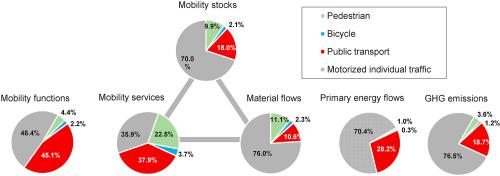Environmental Development ( IF 4.7 ) Pub Date : 2021-03-18 , DOI: 10.1016/j.envdev.2021.100628 Doris Virág 1 , Dominik Wiedenhofer 1 , Willi Haas 1 , Helmut Haberl 1 , Gerald Kalt 1 , Fridolin Krausmann 1

|
Sustainable resource use calls for substantial changes to existing infrastructures, which lock societies into current resource use patterns. Urban mobility is a case in point: existing material stocks of infrastructure and vehicles require large amounts of materials and energy for maintenance and operation in order to provide mobility services, thereby causing considerable emissions. Understanding the stock-flow-service nexus of urban mobility is crucial for achieving progress towards absolute reductions of resource use and emissions. In this article, we investigate personal mobility in an urban context - Vienna. We use stock-driven material and energy flow analysis to quantify mobility stocks and flows for four different modes of mobility: pedestrian, bicycle, public transport and motorized individual traffic (MIT). We quantify material flows for maintenance, expansion, as well as primary energy use and emissions linked to personal mobility within city territory and compare a number of stock-flow-service indicators. Public transport was found to deliver most mobility services (38%), when services were measured as trips. Pedestrian mobility showed the lowest stock intensity of services while using less energy and generating lower emissions per service than any other mobility mode. Trips crossing the city border showed high shares of motorized individual traffic (62–63%). Traffic surfaces dominated material requirements of mobility and are mainly (78%) used by MIT. We conclude that considering stock-flow-service relations can support prioritizing future urban mobility planning, highlight the importance of infrastructure-related measures in doing so and the need for better monitoring especially of mobility service indicators.
中文翻译:

城市背景下个人出行的存量-流动-服务关系:奥地利维也纳
可持续的资源使用要求对现有基础设施进行重大改变,从而将社会锁定在当前的资源使用模式中。城市交通就是一个很好的例子:基础设施和车辆的现有材料库存需要大量的材料和能源来维护和运营,以提供移动服务,从而造成大量排放。了解城市交通的存量-流量-服务关系对于在绝对减少资源使用和排放方面取得进展至关重要。在本文中,我们调查了城市环境中的个人流动性——维也纳。我们使用存量驱动的物质和能量流分析来量化四种不同移动方式的移动存量和流量:行人、自行车、公共交通和机动个人交通 (MIT)。我们量化了用于维护、扩展以及与城市区域内的个人流动相关的一次能源使用和排放的物质流,并比较了一些存量流量服务指标。当服务以出行来衡量时,公共交通提供了大部分的出行服务(38%)。与任何其他出行方式相比,行人出行显示出最低的服务存量强度,同时每项服务使用更少的能源和产生更低的排放。穿越城市边界的旅行显示机动化个人交通的比例很高(62-63%)。交通表面主导了机动性的材料要求,主要(78%)被麻省理工学院使用。我们得出结论,考虑存量-流量-服务关系可以支持优先考虑未来城市交通规划,











































 京公网安备 11010802027423号
京公网安备 11010802027423号